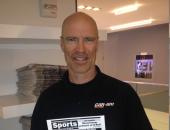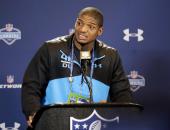 Steven Senne/AP
Steven Senne/APUMass’ Derrick Gordon (l.), using Brooklyn Nets’ Jason Collins, as inspiration, becomes first openly gay player in Division I men’s basketball this week, but men’s golf likely has long way to go before finding similar role model to buck conservative trend.
Over the last couple of months, high-profile male athletes from wide-ranging sports have stepped out of the closet.
University of Massachusetts basketball player Derrick Gordon has received great support since coming out earlier this month.
Gordon was inspired to reveal his sexuality after Jason Collins was signed by the Brooklyn Nets. NFL prospect Michael Sam came out in February. A former Premier League footballer, Thomas Hitzlsperger, came out in January. And British Olympic diver Tom Daley came out as gay last December.
Acknowledging his sexuality hasn’t dampened Daley’s celebrity appeal — in fact, his honesty has endeared him more to the British public. Conspicuous in the absence of an ever-growing list of gay male athletes are golfers. To date, there are no openly gay college or professional players.
The absence of gay male golfers is both surprising and expected — surprising because compared to football or basketball, golf is seen as less masculine. Golfers’ uniforms are pristine and fashionable — almost metrosexual. Players don the fairways with designer skinny pants and matching shirts. Compared to football or basketball, golf is distinctly feminine.
However, golf is doggedly traditional and conservative. The game values its traditions — traditions that still accept the exclusion of women from some clubs. These values are reflected by the demographics of the sport’s fans and club golfers; mostly male, middle-aged and middle income. The Atlantic reported that golf’s fan base is older than any other major sports’ fan base, with the smallest share of teenage and twenty-something TV viewers. This means that although football and basketball are more aggressive and masculine than golf, their fans are younger and by definition, more accepting of gay people.
By contrast, golf’s demographic and patriarchal traditions make it hard for gay male golfers to come out knowing that their sexuality is incongruent with the views of their fan (and sponsorship) base. Same goes for the LPGA.
The demographic of golf’s institutions is at the heart of why metrosexual-appearing male golfers are uncomfortable coming out when athletes from more macho and aggressive sports are. It is understandably difficult for anyone (athlete or not) to reveal a sexuality that deviates from societal norms. However, in the case of basketball or football players, it is easier knowing that your “world” consists of people whose views on homosexuality are evolving in leaps and bounds.
Another factor to consider is the power of role models. Derrick Gordon was able to use Jason Collins as a role model. Someone like him; a black basketball player came out of the closet and the world kept turning. And as more college athletes from various sports come out, it makes it easier for the next gay collegiate athlete from similar sports to come out. Golf has yet to have a role model to join the gay athlete momentum. That is a shame for the sport and a shame for young gay players desperately wanting their sport to accept their sexuality. Will it change soon?
Unfortunately, I don’t think so. Until golf’s institutions have a generational shift, I suspect gay male golfers will have to keep their designer dressed homosexuality in the closet.
* * *
Sue Shapcott is a golf coach and education consultant serving companies in Europe and the USA. She is a former Curtis Cup and European tour player, and a member of the British PGA. She also has a master’s degree in educational psychology and she continues to research the motivation of recreational golfers.
Related Stories  The Score Hears: Messier’s guarantee turns 20
The Score Hears: Messier’s guarantee turns 20  UMass’ Derrick Gordon announces he’s gay in TV interview
UMass’ Derrick Gordon announces he’s gay in TV interview  Ex-Germany midfielder Hitzlsperger: I’m gay
Ex-Germany midfielder Hitzlsperger: I’m gay  Tom Daley, British diver, dating screenwriter: report
Tom Daley, British diver, dating screenwriter: report  Michael Sam says he’s surprised by all the support
Michael Sam says he’s surprised by all the support



